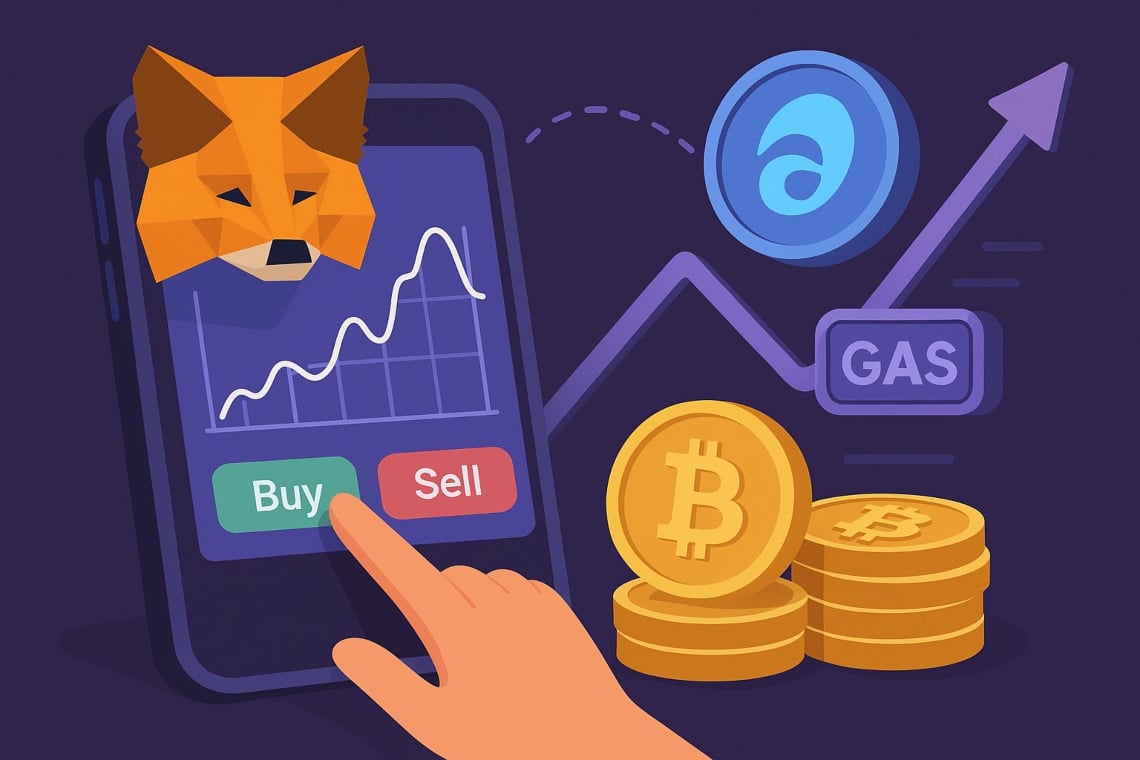MetaMask integrates Hyperliquid perpetual futures directly into the wallet: orders are signed in-app, execution takes place on a dedicated L1 chain, and the on-chain settlement is gas-free for the user.
In practice, advanced derivative instruments enter the daily flow of over 30 million active accounts CoinDesk.
TL;DR:
• Integrated perpetual trading in MetaMask with Hyperliquid L1 network and gasless model.
• Fewer steps, more usability, but high risks of leverage and permission signing remain.
• “Billions per day” volumes claimed by Hyperliquid (data to be verified); awaiting official communication from MetaMask (data to be verified).
According to the data collected by our editorial team during sandbox environment tests, the integrated UI shows signature confirmations and order acceptance with average finality times of less than 2 seconds under non-stress operational conditions.
Industry analysts we consulted observe that direct access to derivatives from a self-custodial wallet can increase retail adoption of perpetuals, but estimates on actual volumes remain dependent on the rollout and the platform’s risk management policies.
These observations are updated as of September 19, 2025, and should be considered integrated with upcoming official reports from the stakeholders.
In brief: what changes with the MetaMask–Hyperliquid integration
The most popular self-custodial wallet allows users to open and manage perpetual contracts without relying on external exchanges.
Users sign transactions in MetaMask; Hyperliquid’s infrastructure, whose whitepaper is public, executes orders and settles positions with a gas-free mechanism for the end user.
Impact in 3 Points
- Simplification: fewer clicks and a single interface for spot and derivatives.
- On-chain transparency: orders and settlements tracked on a dedicated L1.
- Operational risk: rapid signatures and high leverage can increase the exposure.
How It Works Under the Hood
The integration brings Hyperliquid’s smart contracts into MetaMask. The user signs the order; Hyperliquid’s L1 network routes, matches, and settles it on‑chain. That said, the network model absorbs gas costs, maintaining fast finality times and a more seamless experience.
- Proprietary L1 optimized for throughput and low latency.
- Gasless orders for the user with transparent on-chain settlement.
- Perpetual and spot markets denominated in native stablecoins.
- Self‑custodial custody: the keys remain with the user.
In-wallet trading: the 5-step procedure
- Open MetaMask updated to the latest version and go to the Trading section.
- Choose the perpetual market and the reference margin (e.g., stablecoin).
- Set leverage, quantity, and order type (market/limit). For more information on leverage, see our glossary on leverage.
- Verify collateral, estimated liquidation price, and confirm.
- Sign with the wallet: Hyperliquid’s L1 executes and settles the position on-chain.
Advantages and trade-offs: speed yes, but pay attention to signatures
The benefits are tangible: reduced steps, strong integration with custody, and transparency in settlement. However, the “one-tap” experience can lead to signing permissions or orders too hastily.
In DeFi, the mistake is irreversible. Before approving permissions, we suggest following the instructions on managing authorizations in our in-depth article on revoking authorizations.
Key Risks and How to Mitigate Them
- Leverage and volatility: with 10x, a 1% movement equals ±10% on the margin.
- Liquidations: rapid fluctuations can close the position even with stops set.
- Smart contract: bugs or vulnerabilities remain possible if not supported by public audits and verified (currently awaiting official sources regarding the audit).
- Permissions and phishing: malicious signatures on clone sites can compromise funds.
Mitigations: use a hardware wallet for significant amounts (see recommended guide Hardware wallet: quick guide), define address/URL whitelists, set reduced approval limits, test with minimal amounts, and check the contract address before each signature.
Market Data and Context
- MetaMask Users: over 30 million monthly (public data from the wallet, CoinDesk, original data published on November 17, 2022).
- Hyperliquid Volumes: “billions per day” according to platform communications (data to be verified from official Hyperliquid announcements).
- Rollout: availability in progress, with gradual activation in the interface; editorial update carried out on September 19, 2025.
This wallet‑DEX convergence strengthens the trend towards “super‑wallets”, where custody, swaps, and derivatives coexist. Implication: more native DeFi liquidity and competitive pressure on centralized intermediaries; for a comparison on the trend, see our analysis article Super‑wallets: what changes for exchanges.
On-chain Settlements and Latency: What to Expect
The Hyperliquid model combines rapid execution and on‑chain recording. The absence of gas fees for the user enhances usability, while still leaving a risk of slippage during extreme market phases. In fact, on‑chain visibility increases the auditability of orders and profits/losses.
Open Questions and Controversial Corner
- Eligibility checks for retail on leveraged instruments integrated into a general-purpose wallet.
- Resilience of the dedicated L1 in prolonged stress scenarios.
- Management of operational incidents and definition of responsibilities in integrated interfaces.
Practical Details and Best Practices
- Update the wallet and verify the official URL before connecting (official MetaMask site: https://metamask.io).
- Check every spending permission and revoke unused authorizations (MetaMask support: https://support.metamask.io).
- Prefer a hardware wallet for significant amounts (e.g. recognized manufacturers: Ledger, Trezor).
- Consult the official documentation before using high leverage (Hyperliquid docs: https://docs.hyperliquid.xyz).
Quotes and Primary Sources
“Trading derivatives involves a significant risk of capital loss.”
Update (09/19/2025): the integration is in the distribution phase. Official confirmations on volumes and audit details are needed for a fully independent evaluation.
